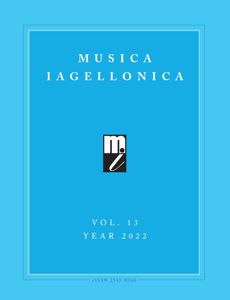‘Everybody liked it / likes it / will like it’: three possible time-related approaches to contrafacta
‘Everybody liked it / likes it / will like it’: three possible time-related approaches to contrafacta
Author(s): Katarzyna SpurgjaszSubject(s): Music
Published by: Musica Iagellonica Sp. z o.o.
Keywords: contrafacts; music history; time; reception; transmission; Catholic music; Lutheran music; early modern music history;
Summary/Abstract: The motives for making contrafacts throughout the music history were related to dif- ferent aspect of the cultural context. This text aims to discuss the approach related to the time, by proposing a theoretical model of past-, present-, and future-related con- trafacta (as well as some mixed types), illustrated by few examples, mainly from early modern music history.The past-related type occurs when the original melody is deeply rooted in collective memory; the new text uses it as a kind of legitimization, or con- tinuation of the same tradition. It is often the case of ritual/liturgical music, which is perceived as valuable and durable; the new text – be it adaptation to a changed context, or translation – is rather an adjustment than a substantial change. The present-related type of contrafacts is based on a temporary popularity of a specific music piece. The ideas of continuation, or stability are not evoked; the author of a contrafact needs only a well-known musical vehicle for a new text, without paying special attention to the cultural function of the original.This type of contrafacts is often used to cross different types of cultural borders with the change of the text (e.g. secular music re-used in sa- cred context, or different versions of a polemic text addressed vice-versa by two groups of people during a confessional or political conflict). The third type, future-related, occurs when a contrafact is introduced to a new audience, not necessarily with a pre- vious knowledge of the original material. This type of contrafacts could be the most independent from the original (in both musical features and text meaning), as the musical material is not a significant part of neither collective nor individual memory and heritage. In the last part of the text, two mixed types (past/future, present/future) are discussed.
Journal: Musica Iagellonica
- Issue Year: 13/2022
- Issue No: 1
- Page Range: 81-92
- Page Count: 12
- Language: English

